PACKET AND FERRY BOATS ON THE OHIO RIVER – 1860 to 1947
Written by David R. Thomas, from KYOWVA Genealogy Society Newsletter, Sept. 1980
Written exactly as typed, but anything in brackets [ ] was my own addition. – Martha J. Martin
The recollections in these lines have been taken directly from the scrapbooks of the BAY SMITH, and THOMAS families; actual newspaper accounts at the time of the events; and other reliable sources.
I am the last of these families that were on the river in the ferry trade in 1947. My grandfather, W. L. THOMAS owned and operated the Augusta Ferry which ran from Boudes Ferry and Augusta, Bracken County, Ky., till around 1899.
My father, Paul F. THOMAS, was according to accounts, probably the best ferryboatman in the Ohio valley. My mother was Virgie Lee SMITH, daughter of William G. and Sarah “Sallie” (BAY) SMITH.
I began working on the “Champion #3” ferry in 1929, becoming an engineer a couple of years later. I was also interested in radio and, in later years, was awarded the World Radio DX (ed. note: DX = distance) Championship, the highest award so far ever issued in DX radio or to a DXer.
I started broadcasting on Nov. 16, 1925, for radio was new, and so during the floods and high water when all roads were blocked, we would take the ferry up and down the river picking up milk, food, and other supplies wherever possible for Huntington [West Virginia] and visa versa.
We would broadcast music and news, to tell folks where they could meet the boat and the times and other river data right in the middle of the standard band! Since the FRC had no license for this type of work, we used a permit, and the call letters WMUS (We’re Unlicensed Marine Station) were used.
With this radio monitoring equipment, I heard the sneak attack on Pearl Harbor and also the flash of the Japanese surrender. My father, at once, ran my oldest daughter, Rosemary down to the ferry “Paul F. THOMAS” and told her to start blowing the whistle, and blow she did.
For a few minutes, only this whistle was heard, and folks started coming to the river bank to see what had happened and what it was all about; in a few more minutes, WSAZ (ed note: local radio station in Huntington, W.Va.) gave the news radio, and soon all the whistles in the area were starting to blow, and soon bedlam reigned.
I have four children, Rosemary (Mrs. William LYNCH), Paul Austin THOMAS, Elizabeth (Mrs. Dale BURCHAM), and Estella Lee (Mrs. Robert LYNCH). I left Proctorville, Lawrence County, Ohio, in 1966 and moved to Tampa, and now do extensive traveling – taking expeditions all over the world.
There are no accurate records of the many skiffs, raft boats, motorboats, ferries, and packet boats that ran on the Ohio River. The first known records are of some of the keel and flatboats, which soon gave way to steamboats and ferries.
The first steamboat on the Ohio River was “New Orleans” in 1811, followed by “Comet” in 1812 and “Vesuvius” in 1813. Memories of the ferry evoke nostalgia — for the stately sternwheelers which puffed from their bustling docks to the inviting green bank on the opposite shore.
Many can remember standing on the deck on a fresh summer morning with the new sun sparkling on the frothy white caps of the river. It wasn’t all tranquility. However, in the days before the dam was constructed, the river sometimes froze over, disrupting ferry service. Ohio commuters then were presented with the alternative of taking an enforced vacation or going to Kenova [West Virginia] to board the N & W train in order to get to Huntington for a day’s work or business.
Or the ice was broken up enough to permit it, and one might take a skiff. There were also times when the river ran low, and the boats were unable to reach the dock — then the passengers were obliged to deff their shoes and wade the remaining distance to shore.
Ohio farmers too, found the ferries not all to be desired. The earlier ferries did not operate at night. Thus farmers who had to make the first-morning ferry in order to get their produce to the city market by the opening time were obliged to line up their trucks and wagons in the dark hours and sleep in them until ferry operations resumed.
There has been over the years (1850-1950) between 15 or 20 maybe more, ferry services from Lawrence County, Ohio, to the West Virginia and Ky. sides, many are incomplete and perhaps forgotten over the years, so only the well-known cases be mentioned:
- 1.) The BAY Brothers (George and William), established one of the best-known packet routes in Upper Ohio.
- 2.) Proctorville-Guyandotte Ferry, which was perhaps the first ferry in the area, going back to the civil war up to 1935.
- 3.) The 26th Street Ferry (1910-1947) between which was the last ferry in operation in this county and the largest and fastest on the Ohio River.
(ed. note: Dictionary definition of “ferry” boat – a boat used to ferry passengers, vehicles, or goods. A packet boat was a passenger boat carrying mail and cargo on a regular schedule.)
Between 1860 – 1880 men born in Lawrence County, Ohio, controlled approx. 75% of the packet boat trade the Ohio and Mississippi rivers. Mr. W. F. DAVISON, from South Point, Ohio was the largest single owner of boats in his day, owning more than 40. Records show that Lawrence County, Ohio men at one time controlled more steamboat property than any other County on inland rivers; and some of the best pilots, masters, and engineers came from Lawrence County, Ohio.
In 1896 the “Nina Paden” was built and started ferry service between Belpre, Ohio, and Parkersburg, West Virginia, commanded by Capt. Noah BUCKNER, who later moved to Proctorville, Ohio with his family – where his sons and a daughter still live.
He was on the “Champion #3” until his death at Proctorville. His son, Walker BUCKNER, who has pilot and engineer papers, was a member of the crew of the 26th Street Ferry Co., until it stopped operation in 1947. Walker also made a model of the “Overa” that can be seen in the Marietta River Museum.
On 27 March 1907, Captain Ellis MACE bought the ferryboat “Pioneer City” from Captain NOLL and renamed it “Central City” and started operations at 14th Street West Huntington, W.Va. 1907 to 1910.
He sold it to some farmers, including U. T. COX and businessmen around Corryville/Bradrick area, for operation in this local area. It ran off and on for several years, without success, and was not in operation when my father bought it and the franchise – and also hired Capt. MACE as a pilot, where he remained until he retired. Capt. MACE is also the author of River Steamboats and Steamboat Men. One of the other early pilots was Lew FRAMPTON.
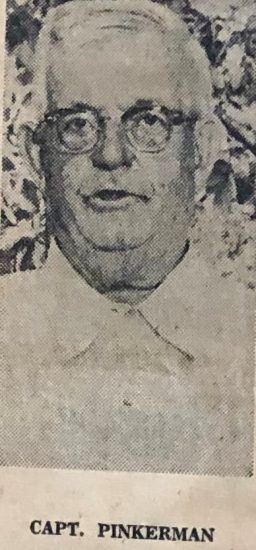
Later my father hired Vinson PINKERMAN, pilot of the defunct Proctorville – Guyandotte Ferry, who remained a pilot for us until ice wrecked the boat in 1947
1.) THE BAY BROTHERS. There is no doubt, that the two BAY brothers were the most prominent steamboat men to ever live in Lawrence County, Ohio. George BAY lived in Proctorville, and his brother William lived in Ironton, Ohio. They were known all over the western waters as the leading steamboatmen on the Ohio River.
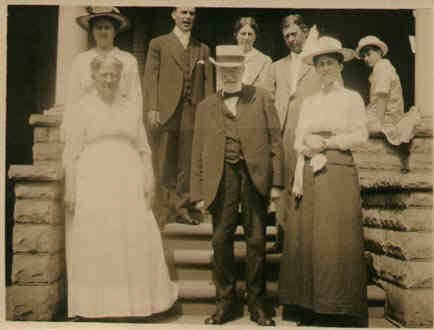
They began this business in 1862 when George BAY bought an old steam scow that had seen its best days. He tried to run it in the Proctorville – Ironton trade but sold it on the first trip when after two days he had gotten no further than Big Sandy.
He bought the scow for $400 and sold it to a man name MOORE for $600. This profit encouraged him to keep at the business, so he and William chartered others boats and went into the transportation business.
Their sister, Sarah “Sallie” BAY married William G. SMITH on 13 Feb. 1866 and was also in the ferry business, running the ferryboat between Proctorville – Guyandotte [West Virginia]. She was one of the first woman pilots on the Ohio River. She and Mrs. Mary (Gordan) GREENE were two of the three pilots listed in 1902.
The BAY BROTHERS built their first boat, the “Minnie“, (named after George BAY’S oldest daughter) in 1868.
Next, they built the “J. C. Crossley” (named for a well-known iron manufacturer from Ironton, Ohio) which ran in Proctorville – Ironton trade and was stoved up in the ice. (Some think this later became a ferry boat, replacing “Liddy Cross”, but no records to verify this that I know of).
Their third boat was the “Scioto” which ran for many years.
The “Lizzie Johnson” was the next boat built, it was wrecked a few years later and rebuilt and named “Rosedale“, which they sold to a company on a river in Arkansas.
They next built the “City of Ironton” which was burned, next came the “Minnie Bay” which sank.
The next boat was “A. L. Norton” which ran for a few years, then rebuilt as a towboat. Then came in this order:
- “Louise“
- “Volunteer” (a screw propeller and iron hull was sold down south somewhere)
- “Chevalier“
- “Lizzy Bay”
- “Henry M. Stanley” was their largest boat built up to now
- “Ruth No. 1” or perhaps “Georgia“(as George BAY named many boats after his daughters, he had 8 daughters and no sons) was a steel hull, known as soft steel plate and twin propellers, every 4 ft.
- “Greyhound“
- “Fannie Dugan” – After Captain John McALLISTER died, his widow consolidated with the BAY BROTHERS and formed Portsmouth – Pomeroy Packet Company., using her boat the “Fannie Dugan” (built in 1872). This company was formed in 1876 and operated beside the “Fannie Dugan,” “J. C. Crossley,” “Fashion'” and the “Lizzie Bay.”
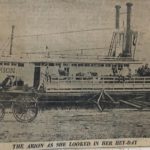
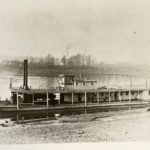
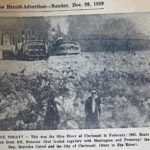
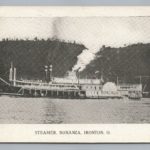
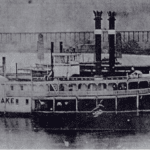
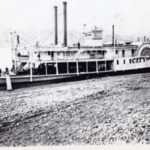
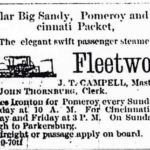
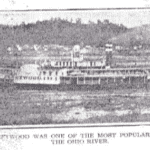
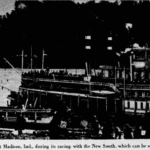
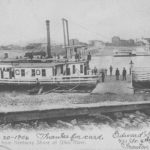
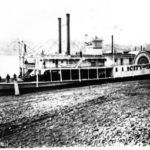
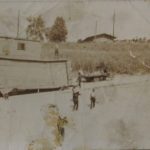
Other boats built/owned by the BAY BROTHERS:
- “Fashion”
- “Ruth” (single-deck boat)
- “Ruth No. 2” (double-deck boat)
- “Kanawha”
- “Urania”
- They bought:
- “B. T. Enos”
- “Nora Belle”
- “Falcon”
- “Henry Logan”
- “Hanging Rock”
- “Sandy Valley”
- “Georgia”
- “Stella”
The “Lizzie Johnson” was named after a girl that was later to become the wife of William BAY. The “Greyhound” was perhaps the last of the BAY BROTHERS boats to remain on the river. The BAY BROTHERS and the White Collar Line were the two lines that were rivals in river trade in this area, but as the White Collar Line was a Cincinnati Company, it will not be considered as Lawrence County, Ohio, history. Captain George BAY died on 6 Feb. 1916 and his brother William BAY died on 4 Dec. 1917.
Sometime between the building of the “Minnie” and the “Scioto,” a mail boat “Fashion” was built to handle the mail between Portsmouth – Proctorville, ca. 1862 – 1872. The “Lizzie Bay” and “Henry M. Stanley” were sold to the White Collar Line. The BAYS would sell anything, for their price, even if it was to a rival competitor.
2.) THE PROCTORVILLE – GUYANDOTTE FERRY. There are no known records of dates when the ferry service started between Proctorville and Guyandotte, WV. Seems like the PARKERS started the ferry service with skiffs or flatboats and later the BUFFINGTON’S operated flatboats, selling out to the BAY’S and SMITH’S. The “Lida Cross” (some spelled it “Linda Cross”) was perhaps the first steam ferry in the area and operated at Proctorville. Some records also show a “Crosley” in here about this time, which could be confused with “J. C. Crossley” that operated by the BAY BROTHERS.
Next ferry boat was in trade with the “Whisper” (sold to Augusta Ferry Company, when the “Arion” was built in 1890 and rebuilt in 1902. The “Arion” was sold to the 26th Street Ferry Company and the franchise was leased to them in 1928, thereby naming the “Arion” the “David F. Thomas.”
The “David F. Thomas” burned on 21 April 1929 and was a total loss. The “Champion No. 3” was bought from Pomeroy – Mason Ferry Company and placed in this trade from 1929 until 1935 when it was dismantled and the franchise given up by the 26th Street Ferry Company.
Between 1935 – 1937 several tried skiff ferries for foot passengers and a steam ferry “Chas. Stone” ran for about a month to try and rebuild the trade, but could not pay expenses and left and the franchise was disbanded.
The memory of the older folks seems to be whether the “Linda Cross” or “Crossley” sank on the dikes which used to be on the Ohio side, below the ferry landing.
When Captain SMITH died the “Arion” nor the ferry fell to his son, George W. SMITH. It fell to BOTH George W. and Ed B. SMITH, who were brothers and owned it equally. This I know for I’m in the family, too, and was on the river when all this was going on.
On July 4, 1912, my father (Paul F. THOMAS) bought 1/3 ownership from my two uncles; for he married their sister and had sold his boat business around Augusta, Ky. (or rather his father had).
On June 23, 1917, my father and Uncle Ed SMITH, sold their interest out to Uncle Ed and Homer HOLT and others, and the Proctorville – Guyandotte Ferry Company was born.
On June 23, 1917, my father and Uncle Ed bought the hot-running ferry “Central City” from Dr. NEAL and other local men and farmers. The service resumed a month later.
The ferry “Relief” is often found in the ferryboat records. This ferry boat was built as a boat to charter while the regular ferry boat was being dry-docked and repaired to rebuild, was owned by Gardner Dock Company of Pt. Pleasant [West Virginia] until [it was] sold to Kline O’NEIL for ferry service at Augusta, Ky.
Following is a list of ferry’s licensed to operate in Lawrence County, Ohio:
| Millersport, Ohio | to | Millersport Landing, WV |
| Athalia, Ohio | to | Lesage, WV |
| Proctorville, Ohio | to | Guyandotte, WV |
| Corryville, Ohio (was moved to Bradrick, Ohio) | to | Upper Huntington, WV |
| Bradrick, Ohio | to | 26th Street, Huntington, WV |
| Rockwood, Ohio* | to | Huntington, WV |
| Chesapeake, Ohio* | to | 10th Street, Huntington, WV* |
| Central City, WV | to | Buffalo Road Landing, Ohio |
| Central City, WV | to | Banks Landing, Ohio** |
** The Banks Landing and Buffalo Road Landing are opposite Central City, or West Huntington and definite service are vague. The possible area around Sybene, [Ohio] and Ceredo, [WV]. Also in this area, Stephen DILLON was the one-half owner of the ferry “Little Lafay.” Mr. DILLON lived in Sybene, Ohio.
Somewhere in this area, Charles BENSON was given a Ferry License to operate a ferry for one year (1901) from Burlington, Ohio to DuPont, WV. (perhaps an area near Ceredo) DuPont, WV must have been opposite Burlington, so listed in Government records. “Wenona” is perhaps the correct name for the steam ferry that ran between Ironton and Russell. There was one in that area by that name.
| Coal Grove, Ohio | to | Ashland, Ky |
| Ironton, Ohio | to | Russell, KY (“Wenona” perhaps) |
| Hanging Rock, Ohio | to | Hanging Rock Landing, Ky. |
Also near county lines:
| Crown City, Gallia County, Ohio | to | Crown City Station, WV |
| Haverhill, Scioto County, Ohio | to | Greenup, Ky |
| South Point, Ohio | to | Catlettsburg, Ky. (Captain Jeff JENKINS) |
Some of these ferries were motor launches, barges being towed, skiffs, and other times of ferries, and were not all steam ferries. Records show that in the 1890’s ferry licenses [were] issued to:
- H. L. BECKETT of Athalia, Ohio
- J. M. BLANKENSHIP, Cox’s Landing
- H. C. WATERS and S. DILLON, Corryville, Ohio
Another note says “Whisper” [was] sold from Proctorville, Ohio to Captain J. D. JENKINS for Haverhill – Greenup trade and he in turn sold it to W. W. O’NEIL for $1,400. Captain JENKINS’ name is mentioned also with Crown City Ferry and the South Point – Catlettsburg Ferry.
There is also mention of the ferry “New Castle” operating between Frampton’s Landing and 7th Street; owned by the FRAMPTON brothers. Later the “New Castle” was replaced by the “Transfer” owned by the following:
HONSHELL and CRAWFORD; The J. M. NOBLE and later EATON. The landing during this time had been moved to 10th Street and Rockwood was renamed Chesapeake.
3.) THE TWENTY-SIXTH STREET FERRY. The 26th Street Ferry was owned and operated by the Twenty-Sixth Street Ferry Company of Proctorville, Ohio, with Captain Paul F. THOMAS being the largest stockholder and the operator from its start to its finish. He was one of the most successful river ferry operators on the Ohio River and during his lifetime had operated ferries at various points along Ohio.
His family before him had operated ferries at Boudes Ferry and Augusta, Ky. Captain THOMAS moved to Proctorville, Ohio in 1913 and became a partner in the Proctorville Ferry. He sold out his interest in 1916 and formed the Twenty-Sixth Street Ferry Company, taking over the operation of the ferry that had operated there and at Central City. When Capt. THOMAS took over, he started an 18-hour service, the first in the area, and later operated 24 hours. This eliminated the long lines and [the] all-night wait the farmers had to [do to] get their produce to the market.
There were many boats used at these operations over the years, including the “Rosemary.” [Her] engines[were] from Clarmont, [and was] built in 1939 at Marietta Shipyards in Pt. Pleasant, WV. [She was ] put in service at 26th Street [Huntington, WV] on 10 Nov. 1939 to handle the business, making it necessary for two boats. [The] War destroyed this business – with gas rationings and change of times. In 1943, [it] was sold to Kline O’NEIL of Augusta Ferry Company.
- “Whisper” [was] sold to Augusta Ferry Company [and] became ” Wonders,” owned by Capt. EDGINTON in 1900.
- “Relief” [was] built as a boat to charter, while other ferry boats were being dry-docked, [or] repaired, and was owned by Gardner Dock Company of Pt. Pleasant [West Virginia]. It was later bought by Kline O’NEIL and was rented at various times to Proctorville, 26th Street Ferry, and 10th Street, and was also used at Augusta, [Ky] as a second ferry. It was [also] used towards [the] last at Proctorville after the “David F. Thomas” burned until “Champion #3” was bought and lastly at 26th Street, as a second ferry to handle the business, while “Oweva” was being wrecked and “Paul F. Thomas” [was] built.
- “7 Wonders”, “Arion,” [were] named for a racehorse – [and was] bought for $4,000. Jan. 1928 [and] renamed “David F. Thomas” – [was] burned in April 1929.
- “Central City” (Paul THOMAS and Ed SMITH bought the not running ferry from Dr. NEAL and other local men and farmers.)
- “David F. Thomas” [was] named for Capt. Paul THOMAS’ son.
- “Oweva” was built on [the] riverbank at 26th Street [on] 28 Feb. 1921. [It’s] name means Ohio/West Virginia. A man was given $10.00 for naming it. {It] started operation on August 1921 and ran steady until the machinery and boiler were moved over on the new ferry hull of “Paul F. Thomas.”
- The “Oweva” hull was made into a landing dock. This boat was very fast and low built – rated as [the] best looking ferry ever built. It could run from 26th Street to Proctorville in ten minutes, in high water.
- “Champion III” [was] bought from Pomeroy – Mason Ferry Company [and] brought to Proctorville in May 1929. [It] operated there until 1935 also at 26th Street during rush hours. [It] was dismantled about 1935?, [the] engines were junked, and [the] pilothouse was brought the [the] brick home in Proctorville, Ohio for [a] playhouse for my kids.
- “Paul F. Thomas” – it was to be named “Oweva” – but on official forms, I filled in Dad’s name, after talking it over in secret with [the] Ferry Company, as a surprise – so it was never changed back.
The “Paul F. Thomas” was built in 1934 at Howard Shipyards in Madison, Indiana. After the hull came to Bradrick, Ohio, the machinery from the “Oweva” was transferred to it. It was the LARGEST and FASTEST sternwheel ferry ever to operate on the Upper Ohio – maybe the whole Ohio River of this construction.
Her speed was around 10-12 mph, upstream against the running river with a full load of 25 cars. She had 2 non-condensing engines using “D” slide valve control, which was from the “Carrie Brown.” Crossing time was three minutes from uniting to tying. She could handle as high as 1600 – 1800 cars a day.
The “Robert E. Lee” was built in 1939 – was larger, but was never successful and was dismantled in about two years. The “Paul F. Thomas” was in steady operation from June 1934 until [the] last week in Dec. 1947, when the damage due to ice and [a] sudden fall in the river – [it] was condemned until repaired.
As Capt. THOMAS was getting old, he decided that the $20,000 it would take to repair it was just too much since the bridge would also become toll-free in a few more years.
The boat was dismantled, the engines, which were those of the “Carrie Brown,” a small freight and towboat that had been destroyed by fire at Gallipolis [on] 18 Nov. 1913, were given to the Ohio State Museum to be reassembled and erected as a memorial to my father. The hull was sold to the folks of Hanging Rock, Ohio, for a boat dock, without any repairs, and later burned. The whistle which was from the packet boat “Tacoma” and had been used on the “Oweva” was donated to the Marietta River Museum.
The fare naturally varied over the years and depended on the type of vehicle. Most cars were ten cents each way. However, at the time tokens were used, the fare was twenty-five cents round trip. Dave THOMAS, in charge of the boat bearing his father’s name, had 1,000 of the tokens struck for use only on the “Paul F. Thomas.”
The other boats continued to use paper tickets with the name of the boat printed on them. (A side note – the 1916 ferry would have four horses to one car. In 1919, at 26th Street Ferry – [it] hauled 300 passengers a day, [and] used a punch ticket, so as to collect by time trip was through. In 1923, the ferry was hauling 14,000 cars a month to 2,000 horse-drawn vehicles, and in 1925 it was 16,000 cars a month to 300 horse-drawn vehicles).
The opening of the Huntington – Chesapeake bridge on 1 May 1926, did not hurt the operation of this ferry, as it was unable to handle all its business. Often 1,500 to 1,800 cars with around 3,000 to 5,000 persons would be a regular day’s service. The business was so heavy in the 1930s that another boat had to be built to help out in the trade.
After the “Paul F. Thomas” was condemned and the cost was too great to rebuild, [the] boat was dismantled, Paul THOMAS decided to close [his] service and [the] books. Thus, ended the ferry service, the last one in this area. Capt. Paul THOMAS died in 1958.

Is there any information about a boat on the Ohio river called the mink 11. I have the skiff to that boat and is in perfect shape. Just would like some background.
Hi Connie,
Please check with your local public library’s local history room. They should be able to help you find books, newspapers, and other places to search for records. If you can subscribe to newspapers.com they have the Owensburg, Ky newspapers online for 1884-1922, and that service is searchable.
Thank you for leaving a comment.
Martha
Hello I am looking for an ancestor that was a river boat captain on the Ohio. He lived in Owensboro, Ky at a time. I know that he was on the river in 1880. His name was Robert Flynn. I was wondering if you can tell me where I might find any records of him. Thank you in advance.